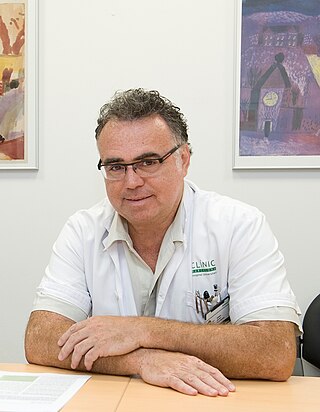Related Research Articles

Antidepressants are a class of medications used to treat major depressive disorder, anxiety disorders, chronic pain, and addiction.

Antipsychotics, also known as neuroleptics, are a class of psychotropic medication primarily used to manage psychosis, principally in schizophrenia but also in a range of other psychotic disorders. They are also the mainstay together with mood stabilizers in the treatment of bipolar disorder.

Bipolar disorder, previously known as manic depression, is a mental disorder characterized by periods of depression and periods of abnormally elevated mood that each last from days to weeks. If the elevated mood is severe or associated with psychosis, it is called mania; if it is less severe, it is called hypomania. During mania, an individual behaves or feels abnormally energetic, happy or irritable, and they often make impulsive decisions with little regard for the consequences. There is usually also a reduced need for sleep during manic phases. During periods of depression, the individual may experience crying and have a negative outlook on life and poor eye contact with others. The risk of suicide is high; over a period of 20 years, 6% of those with bipolar disorder died by suicide, while 30–40% engaged in self-harm. Other mental health issues, such as anxiety disorders and substance use disorders, are commonly associated with bipolar disorder.

Monoamine oxidase inhibitors (MAOIs) are a class of drugs that inhibit the activity of one or both monoamine oxidase enzymes: monoamine oxidase A (MAO-A) and monoamine oxidase B (MAO-B). They are best known as effective antidepressants, especially for treatment-resistant depression and atypical depression. They are also used to treat panic disorder, social anxiety disorder, Parkinson's disease, and several other disorders.

The atypical antipsychotics (AAP), also known as second generation antipsychotics (SGAs) and serotonin–dopamine antagonists (SDAs), are a group of antipsychotic drugs largely introduced after the 1970s and used to treat psychiatric conditions. Some atypical antipsychotics have received regulatory approval for schizophrenia, bipolar disorder, irritability in autism, and as an adjunct in major depressive disorder.

Risperidone, sold under the brand name Risperdal among others, is an atypical antipsychotic used to treat schizophrenia and bipolar disorder. It is taken either by mouth or by injection. The injectable versions are long-acting and last for 2–4 weeks.

Olanzapine is an atypical antipsychotic primarily used to treat schizophrenia and bipolar disorder. For schizophrenia, it can be used for both new-onset disease and long-term maintenance. It is taken by mouth or by injection into a muscle.

Venlafaxine, sold under the brand name Effexor among others, is an antidepressant medication of the serotonin-norepinephrine reuptake inhibitor (SNRI) class. It is used to treat major depressive disorder, generalized anxiety disorder, panic disorder, and social anxiety disorder. Studies have shown that Venlafaxine improves quality of life. It may also be used for chronic pain. It is taken by mouth. It is also available as the salt venlafaxine besylate in an extended-release formulation.

Imipramine, sold under the brand name Tofranil, among others, is a tricyclic antidepressant (TCA) mainly used in the treatment of depression. It is also effective in treating anxiety and panic disorder. Imipramine is taken by mouth.

Clomipramine, sold under the brand name Anafranil among others, is a tricyclic antidepressant (TCA). It is used in the treatment of various conditions, most-notably obsessive–compulsive disorder but also many other disorders, including panic disorder, major depressive disorder, trichotilomania, body dysmorphic disorder and chronic pain. It has also been notably used to treat premature ejaculation and the cataplexy associated with narcolepsy.

Agomelatine, sold under the brand names Valdoxan and Thymanax, among others, is an atypical antidepressant most commonly used to treat major depressive disorder and generalized anxiety disorder. One review found that it is as effective as other antidepressants with similar discontinuation rates overall but fewer discontinuations due to side effects. Another review also found it was similarly effective to many other antidepressants.
The emphasis of the treatment of bipolar disorder is on effective management of the long-term course of the illness, which can involve treatment of emergent symptoms. Treatment methods include pharmacological and psychological techniques.

Dennis S. Charney is an American biological psychiatrist and researcher, with expertise in the neurobiology and treatment of mood and anxiety disorders. He is the author of Neurobiology of Mental Illness, The Physician's Guide to Depression and Bipolar Disorders and Molecular Biology for the Clinician, as well as the author of over 600 original papers and chapters. In 2022, he was listed #52 on Research.com's "Top Medicine Scientists in the United States," with an h-index of 194 with 146,109 citations across 651 publications. Charney is known for demonstrating that ketamine is effective for treating depression. Ketamine's use as a rapidly-acting anti-depressant is recognized as a breakthrough treatment in mental illness.

Selective serotonin reuptake inhibitors (SSRIs) are a class of drugs that are typically used as antidepressants in the treatment of major depressive disorder, anxiety disorders, and other psychological conditions.

Certain lithium compounds, also known as lithium salts, are used as psychiatric medication, primarily for bipolar disorder and for major depressive disorder. In lower doses, other salts such as lithium citrate are known as nutritional lithium and have occasionally been used to treat ADHD. Lithium is taken orally.
Joanna Moncrieff is a British psychiatrist and academic. She is Professor of Critical and Social Psychiatry at University College London and a leading figure in the Critical Psychiatry Network. She is a prominent critic of the modern 'psychopharmacological' model of mental disorder and drug treatment, and the role of the pharmaceutical industry. She has written papers, books and blogs on the use and over-use of drug treatment for mental health problems, the mechanism of action of psychiatric drugs, their subjective and psychoactive effects, the history of drug treatment, and the evidence for its benefits and harms. She also writes on the history and politics of psychiatry more generally. Her best known books are The Myth of the Chemical Cure and The Bitterest Pills.

Eduard Vieta Pascual is a Spanish psychiatrist and a leading scientific authority on the neurobiology and treatment of bipolar disorder.
Mauricio Tohen is a Mexican American research psychiatrist, Distinguished Professor, and Chairman of the Department of Psychiatry & Behavioral Sciences at the University of New Mexico. Tohen's research has focused on the epidemiology, outcome, and treatment of bipolar and psychotic disorders, and is especially known for innovating the design of clinical trials and the criteria to determine outcome in such diseases. Tohen has edited several books on his specialties. His social awareness has been noted in the promotion of programs to improve mental health care in areas such as substance abuse, bipolar disorder and schizophrenia.
Jonathan Otis Cole was a psychiatrist and the former chief of psychopharmacology at McLean Hospital was considered to be the “father of clinical psychopharmacology in the United States ... internationally known for his breakthrough research on the use of drugs to treat psychiatric illnesses.”
Susan Lynn McElroy is Chief Research Officer at Lindner Center of HOPE.
References
- ↑ "Ross J. Baldessarini, M.D., M.A. (hon.), D.Sc. (hon.), DLFAPA, FACP, FACNP, FCINP". International Network for the History of Neuropsychopharmacology. Retrieved 25 June 2021.
- 1 2 "Ross J. Baldessarini, MD". McLean Hospital. Retrieved 25 June 2021.